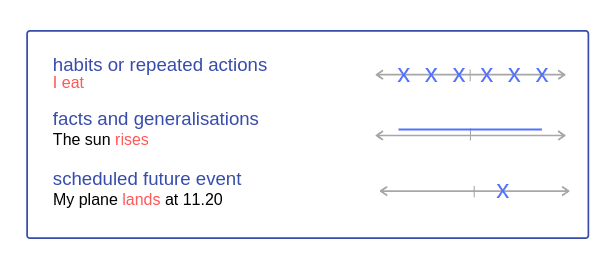ref –
- https://www.grammarly.com/blog/simple-present/
- https://www.natterandramble.co.uk/present-simple-timeline-form-uses/

The simple present is the most basic of the English tenses. It’s used for individual actions or habitual actions in the present.
Often the simple present is just the root verb with no changes or additions. The main exception to this is when the subject is third person and singular. In this case you add the suffix –s. If the verb ends in o, ch, sh, th, ss, gh, or z, you add –es. If the verb ends in a consonant and y (and the subject is third-person singular), drop the y and add –ies.
Today I feel like a million bucks!
My brother carries the groceries while my sister stays on the couch.
When to use the present simple
The present simple is the most commonly used tense in academic writing, so if in doubt, this should be your default choice of tense. There are two main situations where you always need to use the present tense.
Describing facts, generalizations, and explanations
Facts that are always true do not need to be located in a specific time, so they are stated in the present simple. You might state these types of facts when giving background information in your introduction.
- The Eiffel tower is in Paris.
- Light travels faster than sound.
Similarly, theories and generalizations based on facts are expressed in the present simple.
- Average income differs by race and gender.
- Older people express less concern about the environment than younger people.
- Explanations of terms, theories, and ideas should also be written in the present simple.
- Photosynthesis refers to the process by which plants convert sunlight into chemical energy.
- According to Piketty (2013), inequality grows over time in capitalist economies.
Describing the content of a text
Things that happen within the space of a text should be treated similarly to facts and generalizations.
This applies to fictional narratives in books, films, plays, etc. Use the present simple to describe the events or actions that are your main focus; other tenses can be used to mark different times within the text itself.
In the first novel, Harry learns he is a wizard and travels to Hogwarts for the first time, finally escaping the constraints of the family that raised him.
The events in the first part of the sentence are the writer’s main focus, so they are described in the present tense. The second part uses the past tense to add extra information about something that happened prior to those events within the book.
When discussing and analyzing nonfiction, similarly, use the present simple to describe what the author does within the pages of the text (argues, explains, demonstrates, etc).
In The History of Sexuality, Foucault asserts that sexual identity is a modern invention.
Paglia (1993) critiques Foucault’s theory.
This rule also applies when you are describing what you do in your own text. When summarizing the research in your abstract, describing your objectives, or giving an overview of the dissertation structure in your introduction, the present simple is the best choice of tense.
Use present simple to describe habits
I smoke.
I bike.
I play badminton.
I mountain hike.
He drinks tea at breakfast.
She only eats fish.
They watch television regularly.
Use present simple to describe unchanging situations (repeated actions)
I work in the Bay.
I work in London.
I ride the bus to work.
I ride my bike to school.
We catch the bus every morning.
It rains every afternoon in the hot season.
They drive to Monaco every summer.
He goes to office every day.
We paint the walls every year.
He goes for a walk every morning.
She writes a letter every day.
Use present simple to describe general truths
Shenzhen is a green city.
Shanghai is an international city.
Beijing is the capitol of China.
The Earth is round.
Water freezes at zero degrees.
The Earth revolves around the Sun.
Her mother is Peruvian.
Use present simple to describe For instructions or directions
Open the packet and pour the contents into hot water.
You walk down Arvada, and make a left on Entradero. Keep going until the end.
In the third person singular the verb always ends in -s:
– he wants
– she needs
– he gives
– she thinks
I enjoy going to the gym.
She enjoys playing the piano.
He understands English.